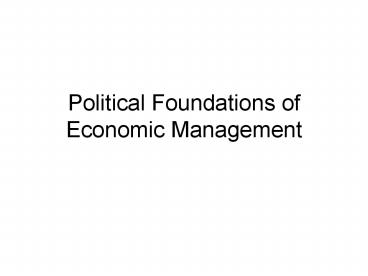Political Foundations of Economic Management - PowerPoint PPT Presentation
Title:
Political Foundations of Economic Management
Description:
economic freedom. property rights. special interests. security of agents' ... The lowest level comes second. The highest level comes third. Economic freedom ... – PowerPoint PPT presentation
Number of Views:55
Avg rating:3.0/5.0
Title: Political Foundations of Economic Management
1
Political Foundations of Economic Management
2
Economic development
- Factors promote growth and development
- Political stability
- Political consensus
- Political freedom
- Economic freedom
3
Financial crisis
- Cope with causes and consequences of financial
crisis - political liberalization
- broad-based economic reform
4
Puzzle of uneven growth
5
Puzzle of uneven growth
- In 1960 the East Asian developing economies had
lower per capita income than developing economies
in either Latin America or sub-Sahara Africa - 1975-90 real GDP per capita grew 5 a year for
East Asian developing economies - 0.04 for Latin America
- 0.3 for sub-Sahara Africa
6
Crisis in South Korea
- corporate failures in 1997
- Hanbo Steel, Sammi Steel, Kia automobile
- capital flight
- credit downgrading
- currency depreciation
7
Adjustments in South Korea
- reform of banking system
- improvement in financial sector
- modification of labor laws
- modification in social security program
8
South Koreas Recovery
9
South Koreas Recovery
10
Taiwan and Singapore
- less damage from (or less vulnerable to)
financial crisis - economic growth slowed down
- solid macroeconomic fundamentals
- current account surpluses
- export of goods and services
- low inflation rates
11
Lessons from Philippines
- In 1950s, best performer and most promising
economy in East Asia - 1960 - 1997, lowest growth rate (1.4 on average)
in East Asia - two periods of negative growth
- 1983 - 1986 and 1991 - 1992
- political turmoil and military coups
12
(No Transcript)
13
Economic growth
- accumulation of reproducible capital
- decisions by individual economic agents
- investment
- consumption
- conditioned and constrained by politics
- political instability
- political polarization
- government repression
14
Political uncertainty
- political instability
- likelihood of the current regime being replaced
in the future - political polarization
- degree of polarization between opposing political
parties - uncertainty in the consistency of public policy
reduces agents incentive to invest
15
Government repression
- Political structural factor
- political freedom
- human rights
- civil rights
- economic freedom
- property rights
- special interests
- security of agents gain from investment
- impose social cost on economic growth
16
Theoretical hypotheses
- Ceteris paribus,
- the lower the probability of the survival of the
current regime, - the more polarized the policy positions of
opposing parties, - the more repressive the government,
- the lower the growth rate
17
Political instability
- 0.33 revolutions per year on average
- 0.14 without the Philippines
18
Political freedom
- 1975 - 1990 average political freedom level
- OECD economies 0.946
- Latin America 0.5
- East Asia 0.454
- sub-Sahara Africa 0.215
19
Democracy and growth
20
Democracy and growth
21
Democracy and growth
22
Robert J. Barro 1996
- Democracy and Growth, in Journal of Economic
Growth, volume 1, pages 1 - 27, March 1996. - The middle level of democracy is most favorable
to economic growth - The lowest level comes second
- The highest level comes third
23
Economic freedom































